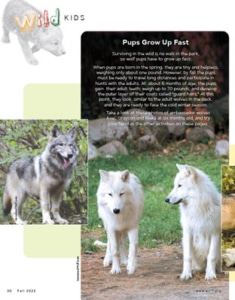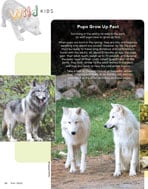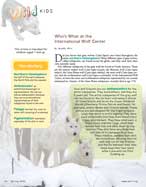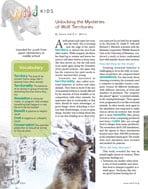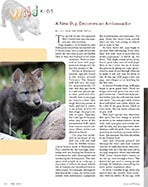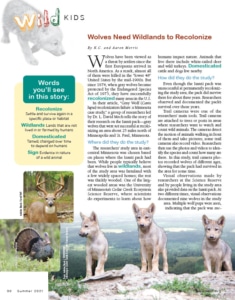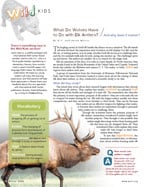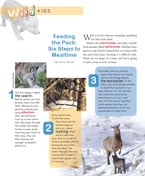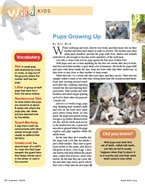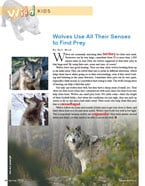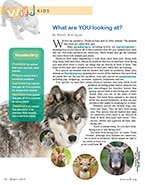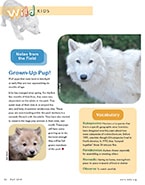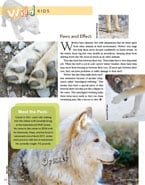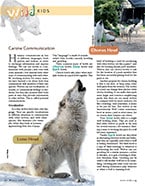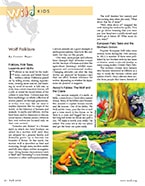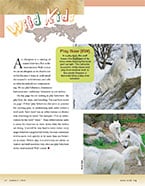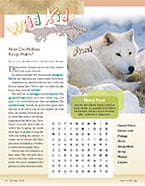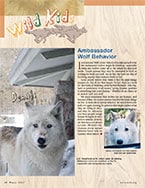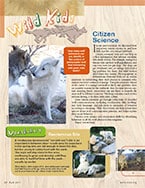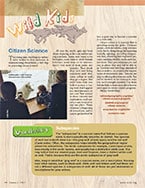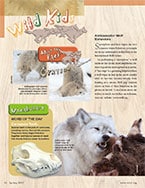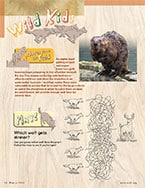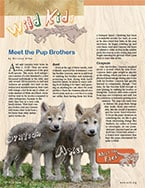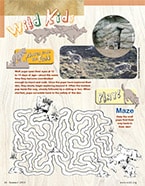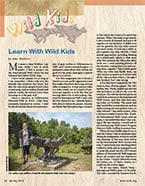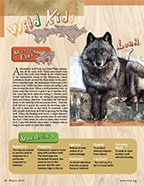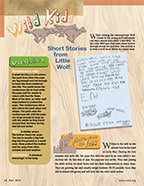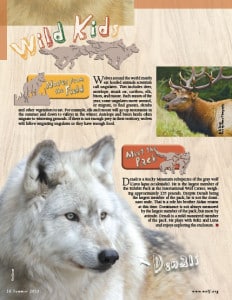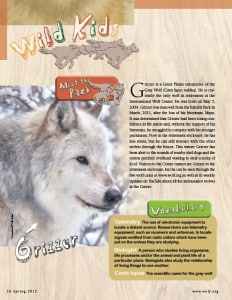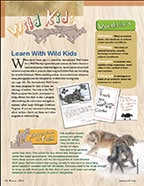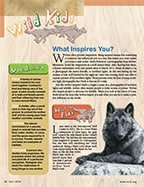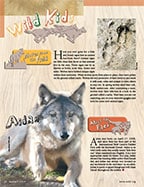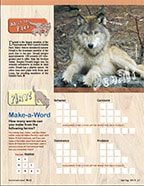Here in the Wild Kids section you’ll find fun facts and stories about wolves and wildlands published in the International Wolf magazine and written just for kids.
Save
Fall 2022
Pups Grow Up Fast
Surviving in the wild is no walk in the park, so wolf pups have to grow up fast!
When pups are born in the spring, they are tiny and helpless, weighing only about one pound. However, by fall the pups must be ready to travel long distances and participate in hunts with the adults.
Word Search
Wolf Hunt Maze
Summer 2022
The Unusual Journey of OR-93
What would happen if you stepped outside your home and kept walking in one direction? Close your eyes and imagine the journey. What sights would you see? Would you walk through cities or towns, over mountains, across rivers, past plains, swamps or lakes? Who would you meet? Would they be friendly or not? How far do you think you would go before you’d want to turn around and head home again?
Wildlife Crossings
Wild animals need to cross roads to search for food or mates, but doing so is dangerous. Wildlife crossings can help. A wildlife crossing can be an underpass—a tunnel where animals cross under the road—or an overpass, which is like a bridge animals use to cross over the road.
Wolves in California
Wolves in California have an interesting history. Before European explorers arrived, wolves lived in many parts of the state, from north to south. After the land was settled, laws were passed to allow humans to protect their livestock by killing wolves and coyotes. In 1924, the last wolf in California was trapped and killed. No wolves called California home for more than 80 years.
Spring 2022
Who’s What at the International Wolf Center
Did you know that gray wolves (Canis lupus) once lived throughout the entire northern hemisphere? Many different types of gray wolves, called subspecies, are found across the globe, and they each have their own scientific name.
Five different subspecies of the gray wolf are found in North America. These are the eastern timber wolf (Canis lupus lycaon), the Mexican wolf (Canis lupus baileyi), the Great Plains wolf (Canis lupus nubilus), the arctic wolf (Canis lupus arctos), and the northwestern wolf (Canis lupus occidentalis). At the International Wolf Center, we have the arctic and northwestern subspecies represented by our current ambassadors. Grizzer, of the Great Plains subspecies, recently died at age 17½.
Vocabulary
Winter 2021
Unlocking the Mysteries of Wolf Territories
by Aaron and K.C. Morris
A wolf pauses and raises her nose into the wind. She is scouting near the edge of her pack’s territory to defend the area from other wolves. While stopped, she flexes her hind leg to urinate and leaves her scent to tell other wolves to keep away. She then moves on, but she will soon scent mark again along the boundary of her pack’s territory—the space that has the resources her pack needs to survive and feed their young.
Scientists are interested in territoriality, also called territorial behavior, in wolves and other animals. They want to know if the size of an animal’s territory is mostly affected by the amount of food available or by competition with other animals. An important idea in territoriality is that there should be more advantages, or good things, about defending a territory than disadvantages, or not-so-great things. Another way to think about this is to say that holding on to their territory must not be too hard for an animal to do. Recently, Dr. Sarah N. Sells and Michael S. Mitchell, scientists with the Montana Cooperative Wildlife Research Unit at the University of Montana, conducted a study to better understand how wild animals choose their territory.
Vocabulary
A deeper look at Territory defense in wolves
Wolves have three main ways to defend their territories from other wolves: scent marking, howling and direct attacks. These defenses work well together because they make wolves aware of other wolves’ territory in different ways and leave violence as a last resort.
Fall 2021
A New Pup Becomes an Ambassador
by Lexi Ham and Abby Keller
The arrival of the International Wolf Center’s new pup this sum-mer was very exciting!
Pups require a lot of attention, and Rieka (pronounced Rye-ka) needed care 24 hours a day for a couple of months before she was ready to join our Exhibit Pack of Axel and Grayson in the main enclosure. Here’s a closer look at how wolf pups grow and change over the first few months of life.
Vocabulary
Meet the Pack
Axel and Grayson are 5 years old, and they belong to the Arctic subspecies of gray wolf.
Summer 2021
Wolves Need Wildlands to Recolonize
by K.C. and Aaron Morris
Wolves have been viewed as a threat by settlers since the first Europeans arrived in North America. As a result, almost all of them were killed in the “lower 48” United States by the mid-1900s. But since 1974, when gray wolves became protected by the Endangered Species Act of 1973, they have successfully recolonized many areas in the U.S.
Vocabulary
Try it yourself…
While some wildlife research requires the use of special equipment like trail cameras, you can practice being a wildlife researcher by using simpler methods like visual observation and tracking at a local park—or in your backyard.
Spring 2021
How Much Room Does a Wolf Pack Need?
Wolf packs live in territories.
A territory is the wild space a pack needs to find resources like food, water and shelter. The size of a pack’s territory can vary a lot depending on prey density, or how much food wolves can find in that area. Just as you’d prefer a snack sitting next to you rather than having to travel all the way to the kitchen for it, wolves don’t want to waste unnecessary energy when finding food, so they use only the space they need.
Vocabulary
Help the wolf locate its prey! Puzzle
Winter 2020
What Do Wolves Have to Do with Elk Antlers?
by K.C. and Aaron Morris
The bugling sound of a bull elk breaks the silence across a meadow. The elk stands
tall near his herd, his impressive rack of antlers on full display. It is fall, and the
elk rut, or mating season, is at its peak. Another bull elk moves in to challenge him,
and the two animals walk side-by-side, sizing one another up. The challenger gives
up and leaves. His antlers are smaller; he is no match for the larger bull.
Vocabulary
Q&A
Fall 2020
Feeding the Pack: Six Steps to Mealtime
by Kyle Mrak
Wolves in the wild are constantly searching for their next meal. Wolves are carnivores, and they usually hunt animals called herbivores. Whether their goal is to get food for themselves or to share with the pack and pups, hunting is a difficult task. There are six stages in a hunt, and we’re going to take a look at each of them.
Vocabulary
Activity: Wolf Hunt Maze
Summer 2020
Pups Growing Up
by Kyle Mrak
When wolf pups are born, they’re very weak, and they must rely on their mother and their pack mates in order to survive. The mother and other adult pack members provide the pups with food, shelter and warmth until they’re old enough to become active members of the wolf pack.
Vocabulary
Activity: Cris Cross
Spring 2020
Wolves Use All Their Senses to Find Prey
by Kyle Mrak
Wolves are constantly searching their territory for their next meal. Territories can be very large—anywhere from 25 to more than 1,000 square miles in size! How are wolves supposed to find their prey in that huge area? By using their ears, noses and eyes, of course!
Vocabulary
Activity: Dot-to-Dot
Winter 2019
What are YOU looking at?
by Phoebe Hartvigsen
Wolves are predators. Predators hunt and eat other animals. The animals they hunt are called their prey.
Many predators, including wolves, are carnivores—meaning they receive almost all of their nutrients from the prey animals they catch and eat—but some predators are omnivores, which means they get the nutrition they need from both animals and plants.
Vocabulary
Activity: Word Search
Fall 2019
Grown-Up Pup!
Wolf pups that were born in late April or early May are now approaching six months of age.
A lot has changed since spring. For the first few months of their lives, they were very dependent on the adults in the pack. They
spent most of their time in or around the den, and later, in summer rendezvous sites. These pups are now traveling within the pack territory in a nomadic lifestyle with the adults. They have also started to observe the large prey animals in their wide, new world. These pups still have some growing up to do, but soon enough they will be full-grown members of the pack.
Activity: Puzzle
Summer 2019
What big teeth you have!
The teeth and jaws of adult gray wolves are well suited to their
diet and hunting methods. Over 90 percent of gray wolves’ diet
is meat, so they must hunt live prey or eat from a carcass. Adult
gray wolves have 42 teeth. Adult humans have only 32. Wolves have several types of teeth that serve different purposes while hunting or eating. These teeth include incisors, canines, carnassial and molars.
Activities: Crossword
Spring 2019
Paws and Effect:
Wolves have fantastic feet with adaptations that set them apart
from other animals in their environment. Wolves’ very large
feet help them move around confidently on harsh terrain. In
the winter those big feet even double as snowshoes, keeping them from sinking down into the snow as much as do other animals.
Activities: Word Search
Winter 2018
Canine Communication
Humans communicate in lots of different languages, both spoken and written, in order to exchange information and express feelings. We can use words to communicate with people—and even with some animals—but animals have other ways of communicating with each other. By studying wolves for many years, we have learned a lot about how they communicate with members of their own species. Wolves can use vocalizations, or sounds, to communicate feelings or situations, but they also position their body parts in ways that provide information to other wolves. This is called postural communication.
Activities: Wolf Search
Fall 2018
Wolf Folklore
Folklore is the word for the traditions, customs and beliefs found within a culture. Folklore is passed on by telling stories, sharing superstitions, creating music and art, and teaching by word-of-mouth. A folk tale, or story, may contain important lessons, tell a joke or reveal the moral values of the culture it came from.
Activities: Start Your Own Story, Word Jumble
Summer 2018
What is an Ethogram? An ethogram is a catalog of animal behaviors. Here at the International Wolf Center we use an ethogram as we observe our wolves because it helps us understand the reason for each behavior, and tells us what the animals are communicating. We see play behaviors, dominance behaviors and confidence behaviors in our wolves.
Activity: Crossword puzzle and vocabulary
Spring 2018
How Do Wolves Keep Warm? During winter, humans put on coats, hats, mittens and boots to go outdoors.
Do wolves wear hats? No! But they have adaptations that help them stay warm outside in the snow. Adaptations are physical traits that have evolved to keep an animal alive. Wolves have very thick fur that keeps them warm all winter.
Activities: Word Find and Match the Characteristics
Hunting Prey
Wolves hunt many different kinds of prey such as ungulates, rodents and rabbits.
Winter 2017
Ambassador Wolf Behavior: International Wolf Center visitors often ask our staff what the ambassador wolves might be thinking—especially when the wolves come up to the windows and peer inside. People assume they may be interested in food or looking for wolf care staff, but in fact, we have no way of knowing exactly what animals think or feel.
Wolf FAQ:
Do wolves eat in a certain order, and is the order based on dominance?
What is the usual eye color of wolves? Can they be blue?
Fall 2017
Citizen Science: In our previous issue, we discussed how important citizen science is, and how kids just like you can get involved.
Citizen scientists’ eyes and ears help us collect information that informs scientists who study wolves.
Vocabulary: Rendezvous site
Ambassador Wolf Behaviors: “Obnoxious Submission”
Lower-ranking wolves approach and greet higher-ranking wolves in a constant—and “annoying”—manner by whining, licking the muzzle and pawing at the higher-ranking wolf’s face.
Summer 2017
Citizen Science: This young man, watching our ambassador wolves in their enclosure, is demonstrating observation, a first step in practicing citizen science!
All over the world, girls and boys dream of putting on lab coats and becoming scientists. Some kids want to be biologists, some want to study human behavior, some want to be astronomers— but most of them make one mistake. They think they can’t start being scientists until they enter college or until they get a degree.
Vocabulary: Subspecies
Ambassador Wolf Behaviors: Jaw sparring is a common wolf behavior in which two wolves jockey for position over each other with open mouths, often accompanied by snarling or growling.
Spring 2017
Notes from the Field: “Dispersal” is a word often used when discussing wild wolves. It comes from the word “disperse,” which means to scatter, distribute or spread over a wide area.
Activity: Arctic Pup Word Find
Ambassador Wolf Behaviors: Snowplows and face wipes are two common winter behaviors you might see in our ambassador wolves here at the International Wolf Center.
Winter 2016
Notes from the Field: As nights start getting crisper and aspen trees turn gold, beavers begin preparing to live all winter beneath the ice.
Activity: Which wolf gets dinner? Can you guess which wolf finds the prey? Follow the lines to see if you’re right!
Meet the Pup Brothers: Adult wolves Aidan, Denali and Boltz have adopted the arctic wolf pups, Axel and Grayson.
Fall 2016
Notes from the Field: We got Axel and Grayson from Canada when they were very young. They came from a litter of four, so they are brothers.
Activity: Arctic Pups Word Find
Meet the Pup Brothers: Axel and Grayson were born on May 2, 2016. They are arctic wolves, a subspecies of the gray wolf species. The arctic wolf subspecies consists of a few hundred to a few thousand individuals in the wild, and only around 100 in captivity, so Axel and Grayson are actually very rare!
Summer 2016
Notes from the Field: With spring just around the corner, wolf pups will be born into the packs.
Vocabulary: Crossword Puzzle
Meet the Pack: The “old man” of our Exhibit pack is Grizzer. He is 12 years old, which is old for a wolf, and he was born on May 5, 2004. Grizzer is a Great Plains subspecies of the gray wolf.
Spring 2016
Notes from the Field: With spring just around the corner, wolf pups will be born into the packs.
Vocabulary: Double Puzzle
Meet the Pack: Boltz came to the International Wolf Center in 2012 when he and Luna were very young pups.
Winter 2015
Notes from the Field: Winter is the easiest time for wolf tracking because in snow, the signs, including tracks, scent posts and scat are more visible.
Activity: Double Puzzle
Meet the Pack: Ambassador wolf Luna is a Great Plains subspecies of the Gray wolf. Three-and-a-half years old, she is the only female in the exhibit pack at the interpretive center in Ely, Minnesota.
Fall 2015
Notes from the Field: Wolves in the wild in this area are born in late April or early May. During the late summer and early fall, the pups live with the pack in an area called a rendezvous site.
Activity: Make a Word
Meet the Pack: Denali is a Rocky Mountain subspecies of the gray wolf (Canis lupus occidentalis). He is the largest member of the Exhibit Pack at the International Wolf Center, weighing approximately 135 pounds.
Summer 2015
Notes from the Field: Wolves around the world mostly eat hoofed animals scientists call ungulates. This includes deer, antelope, musk ox, caribou, elk, bison, and moose.
Activity: Word Find
Meet the Pack: Aidan turned seven years old earlier this year. He continues to be the dominant male in the pack.
Spring 2015
Notes from the Field: Winter is a great time for scientists to track and study wolves, because wolves are easily seen against the white winter snow, especially from an airplane.
Activity: Word Search
Meet the Pack: Grizzer is a Great Plains subspecies of the Gray Wolf (Canis lupus nubilus). He is currently the only wolf in retirement at the International Wolf Center.
Winter 2014
Learn With Wild Kids
When Jacob Tespa, age 12, visited the International Wolf Center for a Wolf Watch program this past summer, he had a chance to learn and practice what biologists do.
Activity: Word Find
Meet the Pack: Boltz is a Great Plains subspecies of the gray wolf (Canis lupus). Boltz joined the exhibit pack July 30, 2012.
Fall 2014
What Inspires You? Wolves often provide inspiration. Being inspired means that something or someone has influenced you in a way that makes you want makes you want to take action.
Activity: Word Find
Meet the Pack: Luna came to the International Wolf Center in 2012. She is a Great Plains subspecies of Canis lupus, the gray wolf. Luna is the only female in the Center’s Exhibit Pack.
Summer 2014
Notes from the Field: Have you ever gone for a hike and found signs that an animal had been there? Animal signs are little clues that show us that animals live in the area. These signs can be as diverse as holes, scaly skin, bones and nests.
Activity: Word Find
Meet the Pack: Aidan was born on April 27, 2008, and since then has been part of the International Wolf Center’s Exhibit Pack with his littermate Denali.
Spring 2014
Birthday Girl Raises Money for Wolves
It’s not every day that a 10-year-old foregoes birthday presents, raises money to support wolves and convinces her parents to travel more than 2,000 miles to deliver the donation in person.
Activity: Make-a-Word
Meet the Pack: Denali is the largest member of the International Wolf Center’s Exhibit Pack. Many visitors mistakenly assume Denali is the dominant member of the pack due to his size.

The International Wolf Center uses science-based education to teach and inspire the world about wolves, their ecology, and the wolf-human relationship.

